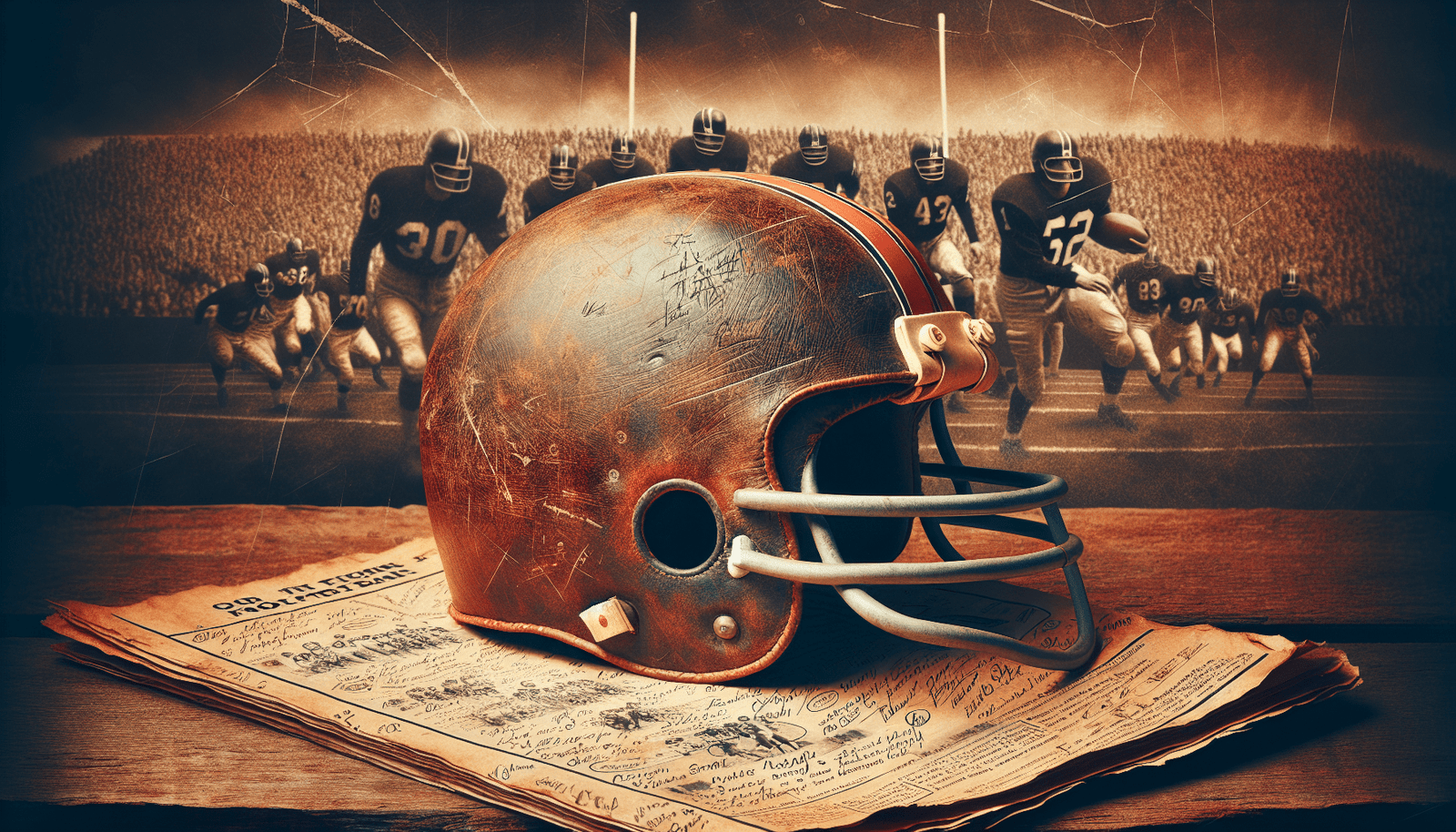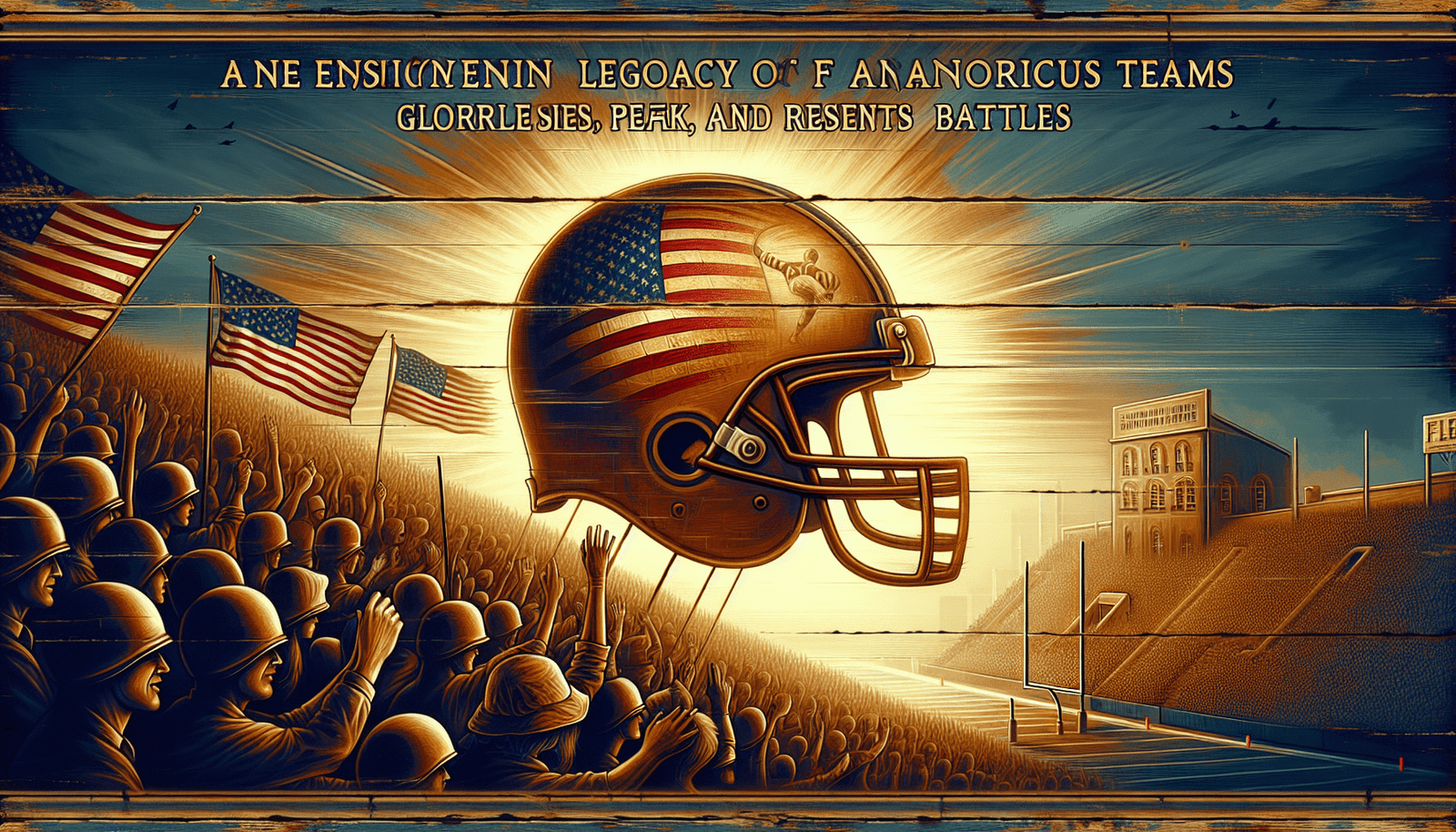Have you ever wondered about the captivating history behind the Cleveland Browns football team? From its humble beginnings in 1946 to becoming a beloved institution in the city, their journey is one filled with triumphs, challenges, and unwavering support from their loyal fans. As you explore the remarkable timeline of this legendary franchise, get ready to immerse yourself in a tale that is sure to leave you in awe of the team’s enduring legacy.

This image is property of pixabay.com.
Origins of the Team
Formation of the Cleveland Browns
The Cleveland Browns football team was founded in 1946 by businessman Arthur “Mickey” McBride and coach Paul Brown. McBride, who was the co-founder and owner of the Cleveland Indians baseball team, saw the potential for professional football in Cleveland and decided to form a football team. Collaborating with Paul Brown, who had achieved success as a high school and college football coach, the Cleveland Browns were born.
Paul Brown Becomes the Head Coach
Paul Brown, a renowned innovator in the game of football, was named the head coach and general manager of the Cleveland Browns. Under his guidance, the team would go on to achieve unprecedented success and become one of the most respected franchises in football history.
Early Years and Successes
First Season in the AAFC
In their inaugural season in 1946, the Cleveland Browns joined the All-America Football Conference (AAFC), which was a rival league to the National Football League (NFL) at the time. Led by coach Paul Brown, the Browns had an impressive first season, finishing with a 12-2 record and winning the AAFC championship.
Dominance in the AAFC
The Cleveland Browns continued to dominate the AAFC in the following years. From 1946 to 1949, they won four consecutive AAFC championships and became the first professional football team to win a championship in their first four seasons. This extraordinary success established the Browns as a force to be reckoned with in the football world.
Joining the NFL
In 1950, the AAFC merged with the NFL, and the Cleveland Browns became part of the prestigious league. Despite the transition to a more competitive environment, the Browns continued their winning ways. In their first season in the NFL, they captured the championship, defeating the Los Angeles Rams. This victory marked the beginning of a new era for the franchise, solidifying their place among the NFL’s elite.
Paul Brown Era
Innovations and Coaching Style
Paul Brown was known for his innovative approach to the game. He introduced several groundbreaking strategies and techniques that revolutionized football. Brown was instrumental in implementing the use of game film for analysis and scouting, the creation of the modern playbook, and the development of the face mask for player safety. His meticulous attention to detail and emphasis on discipline and teamwork set the foundation for the team’s success.
Success in the 1950s
Throughout the 1950s, the Cleveland Browns continued to excel under Paul Brown’s leadership. With star players like Otto Graham, Jim Brown, and Lou Groza, the team consistently reached the playoffs and contended for championships. The Browns won three NFL championships in 1950, 1954, and 1955, solidifying their status as a powerhouse in the league.
End of the Paul Brown Era
Despite their sustained success, tensions between Paul Brown and team owner Art Modell eventually led to Brown’s departure from the team in 1963. His departure marked the end of an era for the Cleveland Browns, as the franchise would go through a series of struggles and changes in the following years.
Struggles and Relocation
Post-Paul Brown Decline
After Paul Brown’s departure, the Cleveland Browns experienced a decline in performance. The team struggled to maintain the same level of success without their revered coach, and they were unable to consistently make the playoffs or contend for championships. The years following Brown’s departure were characterized by instability and coaching changes, hindering the team’s ability to regain their former glory.
Relocation to Baltimore
In 1995, amidst financial difficulties and a controversial decision by owner Art Modell, the Cleveland Browns were relocated to Baltimore and became the Baltimore Ravens. This move deeply devastated Cleveland fans, who had a deep-rooted love and connection to their beloved team. The absence of the Browns left a void in the city’s sports culture, and fans eagerly hoped for their return.
Cleveland Browns Reestablished
After a three-year absence, the Cleveland Browns were officially reestablished in 1999 as an expansion franchise. Led by new owner Al Lerner, the team returned to their home city amidst great fanfare and enthusiasm. This marked a new chapter for the franchise and a renewed sense of hope for the loyal Cleveland fans.

This image is property of pixabay.com.
Return of the Browns
Expansion Franchise
As an expansion franchise, the new Cleveland Browns faced significant challenges. They had to build a team from scratch and establish their identity in a league that had significantly evolved since their departure. Despite the obstacles, the Browns persevered and aimed to create a new legacy that would honor the proud traditions of the past.
Return to Cleveland
Returning to Cleveland meant more than just bringing back a football team – it meant a restoration of pride and a reconnection to a storied history. The city welcomed the Browns with open arms, and the passionate fans turned out in full force to support their beloved team. The return of the Browns brought a sense of unity and community to a city that lived and breathed football.
Struggles in the New Era
While the return of the Browns was met with great enthusiasm, the team faced numerous challenges in trying to regain their footing in the league. Inconsistencies on the field, coaching changes, and ongoing roster rebuilding contributed to a string of losing seasons. However, the resilience of the fanbase and the unwavering support from the city kept hope alive for a brighter future.
New Ownership and Rebuilding
Jimmy Haslam Becomes Owner
In 2012, Jimmy Haslam purchased the Cleveland Browns and became the new owner of the franchise. Haslam brought a new vision and commitment to turning the team’s fortunes around and restoring their winning tradition. Under his ownership, the team embarked on a comprehensive rebuilding process to create a foundation for sustained success.
Coaching Changes
Finding the right coaching staff has been a critical component of the Browns’ rebuilding efforts. Over the years, the team underwent several coaching changes in search of the right leadership to guide them back to prominence. While some coaching regimes showed promise, the constant turnover created instability and impeded the team’s progress.
Rebuilding the Roster
Building a competitive roster has been another key aspect of the Browns’ rebuilding journey. Through the draft, free agency, and trades, the team has worked diligently to acquire talented players and establish a solid core. The process of rebuilding the roster has taken time and patience, but the Browns have made significant strides in assembling a talented and balanced team.

This image is property of pixabay.com.
Recent Years and Challenges
Persistent Quarterback Struggles
One of the biggest challenges the Cleveland Browns have faced in recent years is finding a franchise quarterback. The team has gone through numerous starting quarterbacks, searching for stability and consistency at the position. The persistent struggles to find a long-term solution at quarterback have hindered the team’s ability to gain traction and compete at a high level.
Hue Jackson Era
From 2016 to 2018, Hue Jackson served as the head coach of the Cleveland Browns. Although there was optimism surrounding his arrival, the team struggled to find success under his leadership. The Browns endured multiple losing seasons during the Hue Jackson era, further extending their playoff drought.
Freddie Kitchens Era
Following the departure of Hue Jackson, Freddie Kitchens took over as the head coach of the Cleveland Browns in 2019. However, his tenure was marred by inconsistencies and a lack of cohesion on the field. The team did not perform up to expectations, and Kitchens was subsequently relieved of his duties after just one season.
Playoff Drought and Hope for the Future
Longest Current Playoff Drought
The Cleveland Browns’ playoff drought has been one of the longest in the NFL. Since their return in 1999, the team has struggled to reach the postseason, experiencing a dearth of playoff appearances year after year. However, despite the prolonged absence from the playoffs, there is a renewed sense of optimism and hope for a turnaround.
Baker Mayfield and New Hope
In 2018, the Cleveland Browns selected quarterback Baker Mayfield as the first overall pick in the NFL Draft. Mayfield brought a glimmer of hope to the franchise, showcasing his talent and potential on the field. His leadership and playmaking ability have provided the Browns with a much-needed spark and renewed optimism for the future.
Recent Improvement
In recent years, the Cleveland Browns have shown signs of improvement. Under the leadership of head coach Kevin Stefanski, the team has demonstrated a more disciplined and competitive style of play. The Browns have made significant roster upgrades and have begun to experience success, breaking their long losing streaks and earning their first playoff appearance in 18 years during the 2020 season.

Rivalries and Key Moments
Intense Rivalries
The Cleveland Browns have a rich history of intense rivalries, particularly within their division, the AFC North. The battles against the Pittsburgh Steelers, Baltimore Ravens, and Cincinnati Bengals have produced memorable moments and heated contests. These rivalries have added an added layer of excitement and anticipation to the Browns’ matchups throughout the years.
The Drive and The Fumble
Two key moments in Browns’ history are “The Drive” and “The Fumble.” In the 1986 AFC Championship Game, the Browns had a late lead against the Denver Broncos, only to see quarterback John Elway engineer a game-tying drive that ultimately led to a Broncos victory. A year later, in the 1987 AFC Championship Game, the Browns were in position to score the go-ahead touchdown, but running back Ernest Byner fumbled near the goal line, sealing their defeat. These moments have become synonymous with the heartbreak and resilience of the Browns’ fanbase.
Browns’ Last Playoff Win
The Cleveland Browns’ last playoff win came in the 1994 season when they defeated the New England Patriots in the AFC Wild Card Round. Led by quarterback Vinny Testaverde and coach Bill Belichick, the Browns displayed a dominant performance, marking the last time the franchise tasted postseason success. The victory holds a special place in the hearts of Browns fans, who eagerly await another playoff triumph.
Impact on the City and Fanbase
Cleveland’s Football Culture
Football is deeply ingrained in the fabric of Cleveland’s culture. The city has a long and storied tradition of football, and the Cleveland Browns are a central part of that heritage. The team’s success and struggles over the years have mirrored the city’s ups and downs, and the bond between the team and the community has remained unbreakable.
Dawg Pound and the Fanbase
One of the defining characteristics of the Cleveland Browns’ fanbase is the Dawg Pound. An enthusiastic and passionate group of fans, the Dawg Pound creates a unique and electric atmosphere at the stadium, providing unwavering support for their team. The Dawg Pound has become synonymous with the Cleveland Browns and embodies the unwavering loyalty and dedication of the fanbase.
Cleveland Browns Stadium
Cleveland Browns Stadium, now known as FirstEnergy Stadium, is the home of the Cleveland Browns. The stadium, located on the shores of Lake Erie, has been the site of countless memorable moments and the gathering place for fans to rally behind their team. The stadium holds a special place in the hearts of Cleveland Browns fans and serves as a symbol of the city’s unwavering support for their beloved football team.


